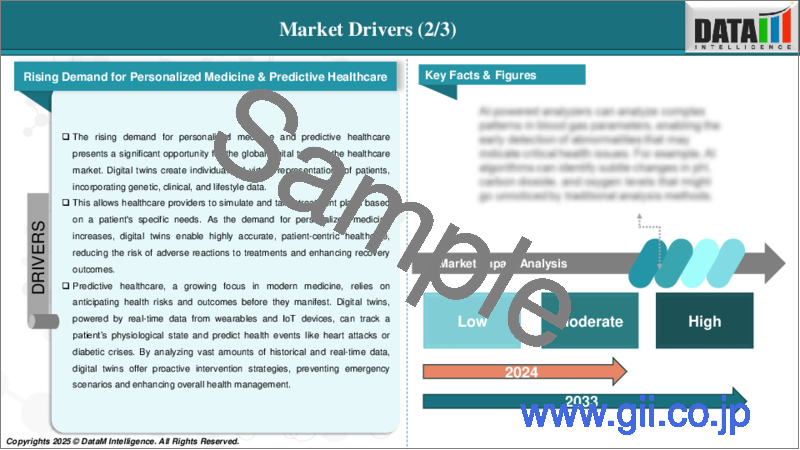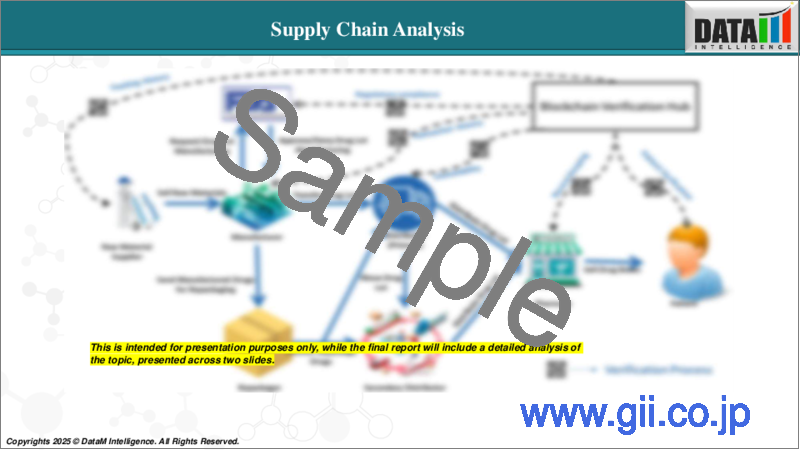|
|
市場調査レポート
商品コード
1629819
医療におけるデジタルツインの世界市場(2024年~2031年)Global Digital Twins in Healthcare Market - 2024-2031 |
||||||
カスタマイズ可能
適宜更新あり
|
|||||||
| 医療におけるデジタルツインの世界市場(2024年~2031年) |
|
出版日: 2024年12月30日
発行: DataM Intelligence
ページ情報: 英文 176 Pages
納期: 即日から翌営業日
|
- 全表示
- 概要
- 目次
世界の医療におけるデジタルツインの市場規模は、2023年に15億5,000万米ドルに達し、2031年には275億米ドルに達すると予測され、予測期間2024年~2031年のCAGRは18.1%で成長すると予測されています。
医療におけるデジタルツインは、患者、病院、その他のシステムを含む物理的な実体やプロセスを表します。電子カルテ(EHR)、疾病登録、オミックスデータに加え、人口統計学的情報やライフスタイル情報が組み込まれています。IoTやAI技術の導入と多次元データの利用可能性により、デジタルツインの探求と有用性が高まっています。デジタルツインをフル活用すれば、ライフスタイル、健康、ウェルネス、慢性疾患の管理に画期的なパターンを提供できます。
市場力学:
促進要因と抑制要因
技術進歩の増加
医療市場におけるデジタルツインの世界の成長は、人工知能、機械学習、IoT、クラウドコンピューティングの技術進歩によってもたらされます。AIとMLは正確な予測モデルの作成を可能にし、病気の進行や治療結果に関する洞察を提供します。IoTの統合により、患者のダイナミックなデジタルレプリカを作成するためのリアルタイムのデータが可能になります。クラウドコンピューティングは、膨大なデータセットの保存と処理を容易にし、医療提供者のアクセシビリティとスケーラビリティを確保します。拡張現実と仮想現実技術は、デジタルツインベースの没入型シミュレーションを提供することで、手術計画や医療トレーニングに変革をもたらしました。これらの進歩は、医療の効率と患者の転帰を改善するだけでなく、診断、個別化医療、医薬品開発への応用の可能性をも広げます。
例えば、2024年5月、Twin Healthは、会員が2型糖尿病の寛解を達成し、投薬が不要になったデジタルツインAIプラットフォームを拡大し、肥満と減量に対応します。Healthy Weightソリューションは、AIと思いやりのある臨床ケアを組み合わせ、会員が投薬なしで健康的な体重を達成できるよう支援します。このプログラムは、GLP-1やその他の高価なヘルス介入への依存を減らすことによる節約によって賄われています。
データのプライバシーとセキュリティ
世界の医療におけるデジタルツイン市場は、データのプライバシーとセキュリティの確保という大きな課題に直面しています。これらのデバイスは、機密性の高い医療記録、遺伝子情報、IoT対応デバイスのデータなど、リアルタイムの患者データ収集に依存しています。このようなデータは、サイバー攻撃、不正アクセス、侵害のリスクにさらされており、患者の信頼を損ない、医療提供者を法的責任や金銭的責任にさらす可能性があります。相互運用可能なシステム全体でデータプライバシーを管理する複雑さは、脆弱性のリスクを増大させます。このような問題に対処するには、強固な暗号化技術、安全なアクセスプロトコル、厳格なコンプライアンス対策が必要ですが、医療機関がこれらを効果的に導入するには、コストがかかり、技術的にも困難な場合があります。
目次
第1章 調査手法と調査範囲
第2章 定義と概要
第3章 エグゼクティブサマリー
第4章 市場力学
- 影響要因
- 促進要因
- 技術進歩の加速
- 抑制要因
- データのプライバシーとセキュリティに関する懸念
- 機会
- 影響分析
第5章 産業分析
- ポーターのファイブフォース分析
- サプライチェーン分析
- 価格分析
- 規制分析
第6章 製品タイプ別
- ソフトウェア
- サービス
- ハードウェア
第7章 用途別
- 診断
- 治療計画
- 患者モニタリング
- 医薬品の創薬と開発
- 医療施設管理
第8章 技術別
- 人工知能(AI)
- 機械学習(ML)
- モノのインターネット(IoT)
- 拡張現実(AR)
- 仮想現実(VR)
第9章 エンドユーザー別
- 病院と診療所
- 製薬・バイオテクノロジー企業
- 学術研究機関
- 診断センター
第10章 地域別
- 北米
- 米国
- カナダ
- メキシコ
- 欧州
- ドイツ
- 英国
- フランス
- スペイン
- イタリア
- その他欧州
- 南米
- ブラジル
- アルゼンチン
- その他南米
- アジア太平洋
- 中国
- インド
- 日本
- 韓国
- その他アジア太平洋
- 中東・アフリカ
第11章 競合情勢
- 競合シナリオ
- 市況・シェア分析
- M&A分析
第12章 企業プロファイル
- Siemens Healthineers
- 会社概要
- 製品ポートフォリオと概要
- 財務概要
- 主な発展
- GE Healthcare
- Philips Healthcare
- Dassault Systemes
- Microsoft Corporation
- IBM Corporation
- Oracle Corporation
- Twin Health
- Medtronic
- Hitachi, Ltd
第12章 付録
The global digital twins in healthcare market reached US$ 1.55 billion in 2023 and is expected to reach US$ 27.5 billion by 2031, growing at a CAGR of 18.1% during the forecast period 2024-2031.
Digital Twins in healthcare represent physical entities and processes, including patients, hospitals, and other systems. They incorporate electronic health records (EHRs), disease registries, and omics data, along with demographic and lifestyle information. The introduction of IoT and AI technologies and the availability of multidimensional data have increased the exploration and usefulness of digital twins. With full utilization, digital twins can provide a breakthrough pattern for managing lifestyle, health, wellness, and chronic diseases.
Market Dynamics: Drivers & Restraints
Increasing Technological Advancements
The global growth of digital twins in the healthcare market is driven by technological advancements in artificial intelligence, machine learning, IoT, and cloud computing. AI and ML enable the creation of accurate and predictive models, providing insights into disease progression and treatment outcomes. IoT integration allows for real-time data for creating dynamic digital replicas of patients. Cloud computing facilitates the storage and processing of massive datasets, ensuring accessibility and scalability for healthcare providers. Augmented reality and virtual reality technologies have transformed surgical planning and medical training, providing immersive simulations based on digital twins. These advancements not only improve healthcare efficiency and patient outcomes but also expand their potential applications in diagnostics, personalized medicine, and drug development.
For instance, in May 2024, Twin Health is expanding its digital twin AI platform, which has helped members achieve remission of type 2 diabetes and eliminate medications, to address obesity and weight loss. The Healthy Weight solution combines AI and compassionate clinical care to help members achieve a healthy weight without medication. The program is funded by savings from reduced reliance on GLP-1s and other costly health interventions.
Data Privacy and Security Concerns
The global digital twins in healthcare market face a significant challenge in ensuring data privacy and security. These devices rely on real-time patient data collection, including sensitive medical records, genetic information, and IoT-enabled device data. This data is at risk of cyberattacks, unauthorized access, and breaches, which can undermine patient trust and expose healthcare providers to legal and financial liabilities. The complexity of managing data privacy across interoperable systems increases the risk of vulnerabilities. Addressing these issues requires robust encryption techniques, secure access protocols, and stringent compliance measures, which can be costly and technically challenging for healthcare organizations to implement effectively.
Segment Analysis
The global digital twins in healthcare market is segmented based on product type, application, technology, end user and region.
Product type:
Software segment is expected to dominate the digital twins in healthcare market share
The software segment holds a major portion of the digital twins in healthcare market share and is expected to continue to hold a significant portion of the digital twins in healthcare market share during the forecast period.
Software is a vital component in the global healthcare market, enabling the creation, management, and utilization of digital twin models. It integrates patient data from various sources, such as EHR, wearable devices, imaging systems, and IoT devices, to create accurate and dynamic virtual replicas of patients or healthcare systems.
These solutions use artificial intelligence and machine learning algorithms to analyze vast datasets, predict disease progression, and simulate treatment outcomes, enabling precision medicine and better clinical decision-making. Software tools also facilitate seamless visualization of digital twins through user-friendly dashboards, enabling healthcare professionals to interact with and manipulate virtual models for diagnostics, treatment planning, and monitoring. As software evolves, it drives innovation in healthcare, making digital twins a central element in patient care and operational efficiency.
Application:
Diagnostics segment is the fastest-growing segment in digital twins in healthcare market share
The diagnostics segment is the fastest-growing segment in the digital twins in healthcare market share and is expected to hold the market share over the forecast period.
Diagnostics has evolved into one of the greatest applications of digital twins in the global health market, thereby transforming, according to world standards, the accuracy and efficiency of detecting and treating diseases. Digital twins, informed by real-time patient data from wearable devices, imaging, and electronic health records, have created highly personalized virtual models of individuals. It allows healthcare professionals to analyze patient-specific conditions and simulate possible disease course scenarios for very early and accurate diagnosis.
For example, among complex diseases such as cancer and those of the cardiovascular system, digital twins can model tumor growth or functioning of the heart to bring those abnormalities to the detection much earlier than was possible with the previous methods. Likewise, they amplify the effectiveness of diagnosis by linking AI and ML algorithms through which such subtle patterns and anomalies would be brought to light, which otherwise may go unnoticed. Such an advancement will bring down the number of misdiagnosis incidents and greatly improve patient outcomes through early interventions. Indeed, as diagnostic technologies become more sophisticated, we will see that the inclusion of digital twins is another revolution in the field-inweaving new standards of personalized and predictive health care.
Geographical Analysis
North America is expected to hold a significant position in the digital twins in healthcare market share
North America holds a substantial position in the digital twins in healthcare market and is expected to hold most of the market share due to advanced infrastructure, technological adoption, and significant investments in digital innovation.
The region's high healthcare spending and focus on personalized medicine create a favorable environment for integrating advanced solutions like digital twins. The region's IoT ecosystem, AI, and ML advancements facilitate the development of dynamic and predictive models. Supportive regulatory frameworks and government initiatives further drive adoption. The increasing prevalence of chronic diseases and demand for remote monitoring and telemedicine services underscore the need for efficient diagnostic and treatment planning tools.
For instance, in December 2023, Twin Health has secured $50 Billion in funding to expand its whole body digital twin service, which uses artificial intelligence to predict and improve chronic metabolic diseases. The service uses data from wearable sensors, clinical lab parameters, and self-reported preferences to create a dynamic model of individual metabolism. The app provides personalized guidance on nutrition, sleep, activity, and stress.
Europe is growing at the fastest pace in the Digital Twins in Healthcare market
Europe holds the fastest pace in the Digital Twins in Healthcare market and is expected to hold most of the market share due to advanced research capabilities, and supportive government policies. Leading technology providers and innovators, such as Germany, the UK, and France, are integrating digital twins into clinical workflows and medical research. Europe's focus on personalized medicine and patient-centric care further accelerates the demand for digital twin solutions. The European Union's Horizon Europe initiative actively funds research and development in digital health, creating opportunities for innovation. The region also benefits from a strong regulatory environment that promotes ethical and secure patient data use. As Europe continues to prioritize technological advancements and healthcare modernization, it plays a pivotal role in shaping the future of digital twins in the healthcare market.
Competitive Landscape
The major global players in the digital twins in healthcare market include Siemens Healthineers, GE Healthcare, Philips Healthcare, Dassault Systemes, Microsoft Corporation, IBM Corporation, Oracle Corporation, Twin Health, Medtronic, Hitachi, Ltd and among others.
Emerging Players
The emerging players in the digital twins in healthcare market include Qure.ai, BioSymetrics, Ansys, Virtonomy and among others.
Key Developments
- In May 2024, Ontrak Inc, a leading AI-powered healthcare company, has launched its Mental Health Digital Twin (MHDT) technology, which combines human empathy with data-driven insights to provide personalized, precise, and effective care for individuals struggling with mental health challenges.
- In February 2024, Unlearn, an AI company, has secured a $50M Series C round led by Altimeter Capital, along with Radical Ventures, Wittington Ventures, Mubadala Capital, Epic Ventures, and Necessary Venture Capital. The funding will help Unlearn advance AI to eliminate trial and error in medicine by investing in its people, data, engineering capabilities, and R&D initiatives.
Why Purchase the Report?
- Pipeline & Innovations: Reviews ongoing clinical trials, product pipelines, and forecasts upcoming advancements in medical devices and pharmaceuticals.
- Product Performance & Market Positioning: Analyzes product performance, market positioning, and growth potential to optimize strategies.
- Real-World Evidence: Integrates patient feedback and data into product development for improved outcomes.
- Physician Preferences & Health System Impact: Examines healthcare provider behaviors and the impact of health system mergers on adoption strategies.
- Market Updates & Industry Changes: Covers recent regulatory changes, new policies, and emerging technologies.
- Competitive Strategies: Analyzes competitor strategies, market share, and emerging players.
- Pricing & Market Access: Reviews pricing models, reimbursement trends, and market access strategies.
- Market Entry & Expansion: Identifies optimal strategies for entering new markets and partnerships.
- Regional Growth & Investment: Highlights high-growth regions and investment opportunities.
- Supply Chain Optimization: Assesses supply chain risks and distribution strategies for efficient product delivery.
- Sustainability & Regulatory Impact: Focuses on eco-friendly practices and evolving regulations in healthcare.
- Post-market Surveillance: Uses post-market data to enhance product safety and access.
- Pharmacoeconomics & Value-Based Pricing: Analyzes the shift to value-based pricing and data-driven decision-making in R&D.
The global digital twins in healthcare market report delivers a detailed analysis with 60+ key tables, more than 50 visually impactful figures, and 176 pages of expert insights, providing a complete view of the market landscape.
Target Audience 2023
- Manufacturers: Pharmaceutical, Medical Device, Biotech Companies, Contract Manufacturers, Distributors, Hospitals.
- Regulatory & Policy: Compliance Officers, Government, Health Economists, Market Access Specialists.
- Component & Innovation: AI/Robotics Providers, R&D Professionals, Clinical Trial Managers, Pharmacovigilance Experts.
- Investors: Healthcare Investors, Venture Fund Investors, Pharma Marketing & Sales.
- Consulting & Advisory: Healthcare Consultants, Industry Associations, Analysts.
- Supply Chain: Distribution and Supply Chain Managers.
- Consumers & Advocacy: Patients, Advocacy Groups, Insurance Companies.
- Academic & Research: Academic Institutions.
Table of Contents
1. Methodology and Scope
- 1.1. Research Methodology
- 1.2. Research Objective and Scope of the Report
2. Definition and Overview
3. Executive Summary
- 3.1. Snippet by Product Type
- 3.2. Snippet by Application
- 3.3. Snippet by Technology
- 3.4. Snippet by End User
- 3.5. Snippet by Region
4. Dynamics
- 4.1. Impacting Factors
- 4.2. Drivers
- 4.2.1. Increasing Technological Advancements
- 4.2.2. XX
- 4.3. Restraints
- 4.3.1. Data Privacy and Security Concerns
- 4.4. Opportunity
- 4.4.1. Impact Analysis
5. Industry Analysis
- 5.1. Porter's Five Force Analysis
- 5.2. Supply Chain Analysis
- 5.3. Pricing Analysis
- 5.4. Regulatory Analysis
6. By Product type
- 6.1. Introduction
- 6.1.1. Market Size Analysis and Y-o-Y Growth Analysis (%), By Product type
- 6.1.2. Market Attractiveness Index, By Product type
- 6.2. Software*
- 6.2.1. Introduction
- 6.2.2. Market Size Analysis and Y-o-Y Growth Analysis (%)
- 6.3. Services
- 6.4. Hardware
7. By Application
- 7.1. Introduction
- 7.1.1. Market Size Analysis and Y-o-Y Growth Analysis (%), By Application
- 7.1.2. Market Attractiveness Index, By Application
- 7.2. Diagnostics*
- 7.2.1. Introduction
- 7.2.2. Market Size Analysis and Y-o-Y Growth Analysis (%)
- 7.3. Treatment Planning
- 7.4. Patient Monitoring
- 7.5. Drug Discovery and Development
- 7.6. Healthcare Facility Management
8. By Technology
- 8.1. Introduction
- 8.1.1. Market Size Analysis and Y-o-Y Growth Analysis (%), By Technology
- 8.1.2. Market Attractiveness Index, By Technology
- 8.2. Artificial Intelligence (AI)*
- 8.2.1. Introduction
- 8.2.2. Market Size Analysis and Y-o-Y Growth Analysis (%)
- 8.3. Machine Learning (ML)
- 8.4. Internet of Things (IoT)
- 8.5. Augmented Reality (AR)
- 8.6. Virtual Reality (VR)
9. By End User
- 9.1. Introduction
- 9.1.1. Market Size Analysis and Y-o-Y Growth Analysis (%), By End User
- 9.1.2. Market Attractiveness Index, By End User
- 9.2. Hospitals and Clinics*
- 9.2.1. Introduction
- 9.2.2. Market Size Analysis and Y-o-Y Growth Analysis (%)
- 9.3. Pharmaceutical and Biotechnology Companies
- 9.4. Academic and Research Institutes
- 9.5. Diagnostic Centers
10. By Region
- 10.1. Introduction
- 10.1.1. Market Size Analysis and Y-o-Y Growth Analysis (%), By Region
- 10.1.2. Market Attractiveness Index, By Region
- 10.2. North America
- 10.2.1. Introduction
- 10.2.2. Key Region-Specific Dynamics
- 10.2.3. Market Size Analysis and Y-o-Y Growth Analysis (%), By Product Type
- 10.2.4. Market Size Analysis and Y-o-Y Growth Analysis (%), By Application
- 10.2.5. Market Size Analysis and Y-o-Y Growth Analysis (%), By Technology
- 10.2.6. Market Size Analysis and Y-o-Y Growth Analysis (%), By End User
- 10.2.7. Market Size Analysis and Y-o-Y Growth Analysis (%), By Country
- 10.2.7.1. U.S.
- 10.2.7.2. Canada
- 10.2.7.3. Mexico
- 10.3. Europe
- 10.3.1. Introduction
- 10.3.2. Key Region-Specific Dynamics
- 10.3.3. Market Size Analysis and Y-o-Y Growth Analysis (%), By Product Type
- 10.3.4. Market Size Analysis and Y-o-Y Growth Analysis (%), By Application
- 10.3.5. Market Size Analysis and Y-o-Y Growth Analysis (%), By Technology
- 10.3.6. Market Size Analysis and Y-o-Y Growth Analysis (%), By End User
- 10.3.7. Market Size Analysis and Y-o-Y Growth Analysis (%), By Country
- 10.3.7.1. Germany
- 10.3.7.2. U.K.
- 10.3.7.3. France
- 10.3.7.4. Spain
- 10.3.7.5. Italy
- 10.3.7.6. Rest of Europe
- 10.4. South America
- 10.4.1. Introduction
- 10.4.2. Key Region-Specific Dynamics
- 10.4.3. Market Size Analysis and Y-o-Y Growth Analysis (%), By Product Type
- 10.4.4. Market Size Analysis and Y-o-Y Growth Analysis (%), By Application
- 10.4.5. Market Size Analysis and Y-o-Y Growth Analysis (%), By Technology
- 10.4.6. Market Size Analysis and Y-o-Y Growth Analysis (%), By End User
- 10.4.7. Market Size Analysis and Y-o-Y Growth Analysis (%), By Country
- 10.4.7.1. Brazil
- 10.4.7.2. Argentina
- 10.4.7.3. Rest of South America
- 10.5. Asia-Pacific
- 10.5.1. Introduction
- 10.5.2. Key Region-Specific Dynamics
- 10.5.3. Market Size Analysis and Y-o-Y Growth Analysis (%), By Product Type
- 10.5.4. Market Size Analysis and Y-o-Y Growth Analysis (%), By Application
- 10.5.5. Market Size Analysis and Y-o-Y Growth Analysis (%), By Technology
- 10.5.6. Market Size Analysis and Y-o-Y Growth Analysis (%), By End User
- 10.5.7. Market Size Analysis and Y-o-Y Growth Analysis (%), By Country
- 10.5.7.1. China
- 10.5.7.2. India
- 10.5.7.3. Japan
- 10.5.7.4. South Korea
- 10.5.7.5. Rest of Asia-Pacific
- 10.6. Middle East and Africa
- 10.6.1. Introduction
- 10.6.2. Key Region-Specific Dynamics
- 10.6.3. Market Size Analysis and Y-o-Y Growth Analysis (%), By Product Type
- 10.6.4. Market Size Analysis and Y-o-Y Growth Analysis (%), By Application
- 10.6.5. Market Size Analysis and Y-o-Y Growth Analysis (%), By Technology
- 10.6.6. Market Size Analysis and Y-o-Y Growth Analysis (%), By End User
11. Competitive Landscape
- 11.1. Competitive Scenario
- 11.2. Market Positioning/Share Analysis
- 11.3. Mergers and Acquisitions Analysis
12. Company Profiles
- 12.1. Siemens Healthineers*
- 12.1.1. Company Overview
- 12.1.2. Product Portfolio and Description
- 12.1.3. Financial Overview
- 12.1.4. Key Developments
- 12.2. GE Healthcare
- 12.3. Philips Healthcare
- 12.4. Dassault Systemes
- 12.5. Microsoft Corporation
- 12.6. IBM Corporation
- 12.7. Oracle Corporation
- 12.8. Twin Health
- 12.9. Medtronic
- 12.10. Hitachi, Ltd
LIST NOT EXHAUSTIVE
12. Appendix
- 12.1 About Us and Services
- 12.2 Contact Us






